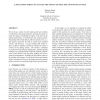Free Online Productivity Tools
i2Speak
i2Symbol
i2OCR
iTex2Img
iWeb2Print
iWeb2Shot
i2Type
iPdf2Split
iPdf2Merge
i2Bopomofo
i2Arabic
i2Style
i2Image
i2PDF
iLatex2Rtf
Sci2ools
WSC
2008
2008
A simulation model to analyze the impact of hole size on putting in golf
We develop a model of golfer putting skill and combine it with physics-based putt trajectory and holeout models to study the impact of doubling the radius of the hole on the putting performance of professional and amateur golfers. The putting skill model reflects golfer execution errors, i.e., that golfers cannot hit the ball at exactly their intended velocity and direction. A green reading skill model reflects a golfer's inability to perfectly estimate the slope or contour of the putting surface. The model is calibrated to professional and amateur putting data. Optimal putting strategies are computed using stochastic dynamic programming. Quasi-Monte Carlo and other methods are used to speed up computations. Doubling the hole radius improves the putting performance of both professional and amateur golfers, as expected. However, the improvementfor amateur golfers is shown to be relatively larger than for professionals.
| Added | 02 Oct 2010 |
| Updated | 02 Oct 2010 |
| Type | Conference |
| Year | 2008 |
| Where | WSC |
| Authors | Matulya Bansal, Mark Broadie |
Comments (0)

